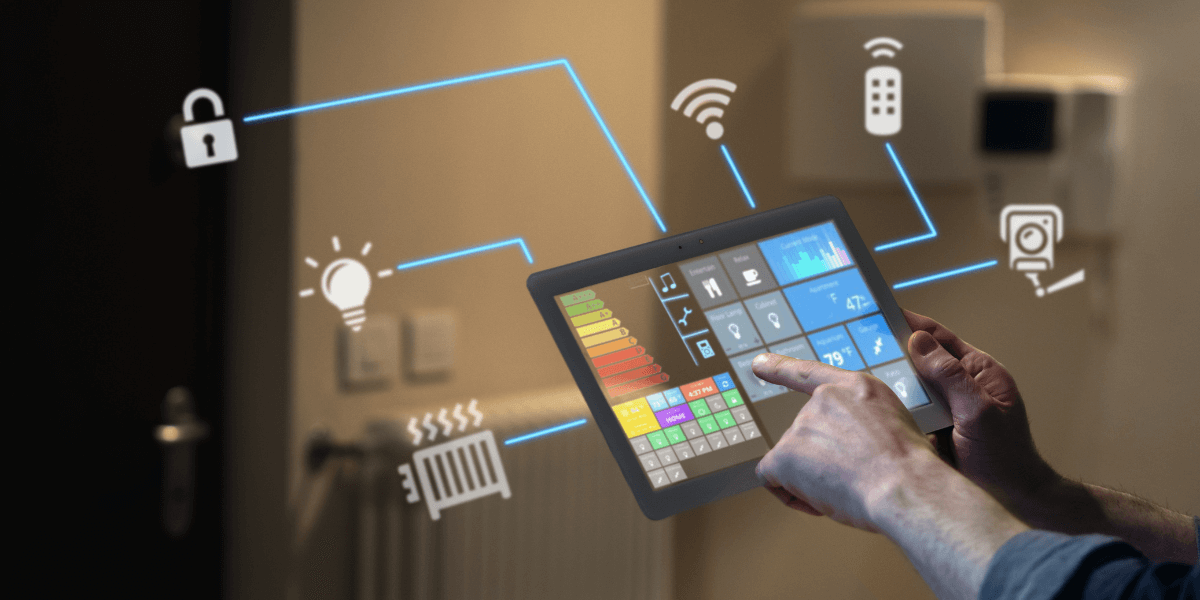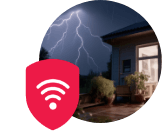Why Your Smart Home Needs to Be Powered by Fiber Internet

Table of Contents
If you’re one of the high-tech, cool people who are implementing the latest gadgets in your home, you can probably relate to this dilemma. Imagine: You’re rushing out the door for work when you realize you forgot to turn off the lights. No problem—you can just grab your phone and tap the smart home app.
But instead of an instant response, you watch a spinning loading icon for what feels like forever. Your smart doorbell notification from five minutes ago has just arrived, and your security camera feed appears to be streaming with the quality of a video camera from 2001.
What is the point of having all these smart home gadgets if they don’t make life easier?!
We’ve been there. The truth is, your smart home is only as intelligent as the internet connection powering it. While many homeowners focus on buying the latest smart devices, they often overlook the foundation that makes everything work seamlessly: a robust, high-speed internet connection. That’s where Fidium Fiber’s high-speed fiber internet comes in—not just as an upgrade, but as an absolute necessity for smart homes.

The Smart Home Bandwidth Reality Check
Smart homes are rapidly becoming the standard. The average U.S. household is projected to require over 2Gbps of broadband speed by 2030, driven by the explosion of connected devices and immersive services [1]. That’s not a typo—we’re talking about gigabit speeds becoming the baseline, not the premium tier. Smart home enthusiasts often have 20, 30, or even more than 50 connected devices throughout their homes.
These devices aren’t just sitting idle, either. Smart thermostats constantly monitor temperatures, security cameras record footage, voice assistants process commands, and smart appliances send status updates. To power an entire smart home network, most connectivity experts recommend a minimum of 25 Mbps per device. But faster is always better.
Not All Smart Devices Are Created Equal
Understanding which devices consume the most bandwidth helps explain why many traditional internet connections fall short.
Low-Bandwidth
Some smart devices are surprisingly modest in their internet appetite. Smart gadgets, like the LED smart bulb, are quite frugal when it comes to data usage. On average, they only use about 20-30 MB per month to communicate with your phone. Smart plugs, basic sensors, and simple automation devices typically fall into this category.
The Bandwidth Hungry Devices
Security cameras represent the biggest bandwidth consumers in most smart homes. High Definition (HD) Cameras (720p): 1-2 Mbps per camera, while you should have 2 Mbps upload for each 1080P 30 FPS camera or 4 Mbps for each 4K 20 FPS Camera [2, 3].
Why Upload Speed Matters More Than You Think
Most people obsess over download speeds when shopping for internet service, but smart homes flip this priority on its head. For the vast majority of people, the limiting factor will be the upload speed. This is because many smart devices constantly send data to cloud services rather than just receiving it.
Security cameras illustrate this perfectly. Given that the majority of big-name cloud-based systems like Nest and Ring stream to the cloud and then to your home, even when you’re at home right there with the cameras, the upload speed matters.
Traditional internet connections like cable and DSL typically offer asymmetrical speeds. Internet providers usually allocate 10% of your download speed for your upload speed. So if your internet plan says 100 Mbps, your upload speed would be 10 Mbps. For a smart home with multiple security cameras, this creates an immediate bottleneck.

Symmetrical speeds are possible!
The Fiber Advantage
Fiber internet fundamentally changes how your smart home operates.
Symmetrical Speeds
The exception to these asymmetrical speeds is fiber internet, which tends to be more generous with upload bandwidth than other types of internet. With a fiber internet connection, you would usually get equally fast upload and download speeds.
For smart homes, this translates to immediate benefits. Security cameras can stream crystal-clear footage without buffering, cloud backups happen instantly, and video calls never pixelate when someone else in the house is using the internet.
Ultra-Low Latency for Real-Time Response
Latency—the time it takes for data to travel between your device and the internet—might seem insignificant, but it makes or breaks the smart home experience. Fiber typically delivers lower latency (10-15ms) compared to cable (15-30ms).
Fiber’s ultra-low latency makes smart home automation feel truly responsive. When you tap your phone to unlock the front door, you want it to happen immediately—not after an awkward pause that leaves you standing on your doorstep.
Rock-Solid Reliability
Smart homes require internet connections that operate reliably, regardless of external conditions. Cable internet can struggle during peak usage times when many neighbors are online simultaneously.
Fiber, on the other hand, offers higher reliability because its cables are almost always grounded and protected from the elements. Power outages also won’t affect fiber internet, since it doesn’t rely on electricity to function.
Fiber vs. Traditional Internet
Real-world performance differences become clear when examining common smart home scenarios.
Family Movie Night Security Check
It’s Friday evening, and your family is streaming a 4K movie while you check the security cameras before settling in for the night. With traditional cable internet offering asymmetrical speeds, the combination of high download usage (4K streaming) and upload demand (camera feeds) creates competition for limited bandwidth. The movie might buffer, camera feeds could pixelate, and smart home responses could slow down.
With fiber’s symmetrical speeds, the 4K stream downloads at full speed while security cameras simultaneously upload clear footage. Both activities happen seamlessly without affecting each other.
Work-From-Home Reality
You’re leading a vital video conference while your smart home continues its regular operations—security cameras monitor the property, smart thermostats adjust temperatures, and other family members use the internet. Traditional connections often force you to choose between professional video quality and smart home functionality.
Fiber provides enough bandwidth for crystal-clear video conferencing while maintaining all smart home operations simultaneously.
Gaming and Entertainment
Fiber is better for gaming because games need fast speeds with low latency. The symmetrical speeds of fiber internet also allow you to chat with others or stream your gaming with no issues, unlike the asymmetrical upload speeds from cable internet.
Modern gaming involves more than just playing—it includes streaming gameplay, downloading massive game updates, and communicating with other players. Fiber handles all these demands simultaneously while maintaining smart home operations.
Optimizing Your Smart Home Network
Even with fiber internet, smart home performance depends on a proper network setup.
Invest in Quality Equipment
Your router serves as the central hub for all communication within your smart home. A high-quality router with dual-band or tri-band capabilities can significantly improve coverage. Mesh Wi-Fi systems offer an effective solution for large homes by eliminating dead zones and ensuring seamless connectivity across multiple rooms.
Strategic Device Management
Place bandwidth-intensive devices, such as security cameras, closer to Wi-Fi access points when possible. For devices that support it, wired connections eliminate Wi-Fi congestion and provide the most stable performance.
Planning Your Smart Home
Calculating your home’s bandwidth needs requires considering both current devices and future expansion.
Peak Usage Planning
Your household’s peak usage periods are key to determining your actual speed requirements. For example, if multiple family members are streaming HD content while security cameras are recording and someone is on a video call, your bandwidth usage increases significantly.
Plan for worst-case scenarios when multiple high-bandwidth activities happen simultaneously. Fidium Fiber’s abundant bandwidth ensures smooth performance even during peak demand periods.
Future-Proofing Considerations
Leave extra bandwidth for adding future internet-connected gadgets, which you will likely do. Smart home technology evolves rapidly, and today’s adequate connection might struggle with tomorrow’s devices.
Ready to Power Your Smart Home with Fidium Fiber?
Fidium Fiber delivers the symmetrical speeds, low latency, and rock-solid reliability your smart home demands. Enter your zip code here to see if Fidium Fiber is available in your area and discover how fiber internet can transform your smart home experience.
Sources
[1] Fiberbroadband.org. “Smart Home and IoT Innovations Take Center Stage at Fiber Connect 2025"
[2] Safemo.com. “Best Security Camera Internet Speed"
[3] Getscw.com. “Internet Speed Camera Viewing"












 Call
Call 

 Access Your Account
Access Your Account